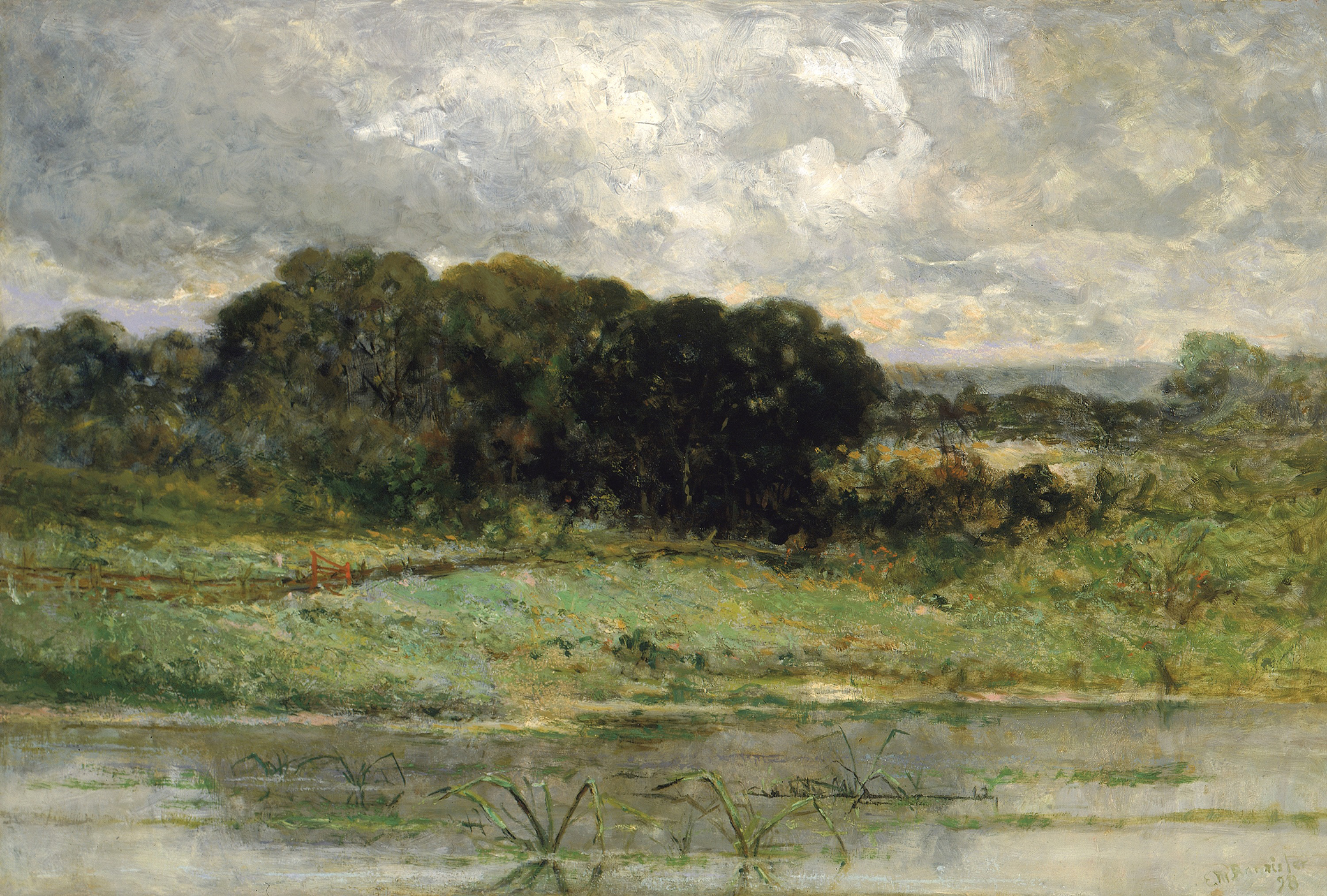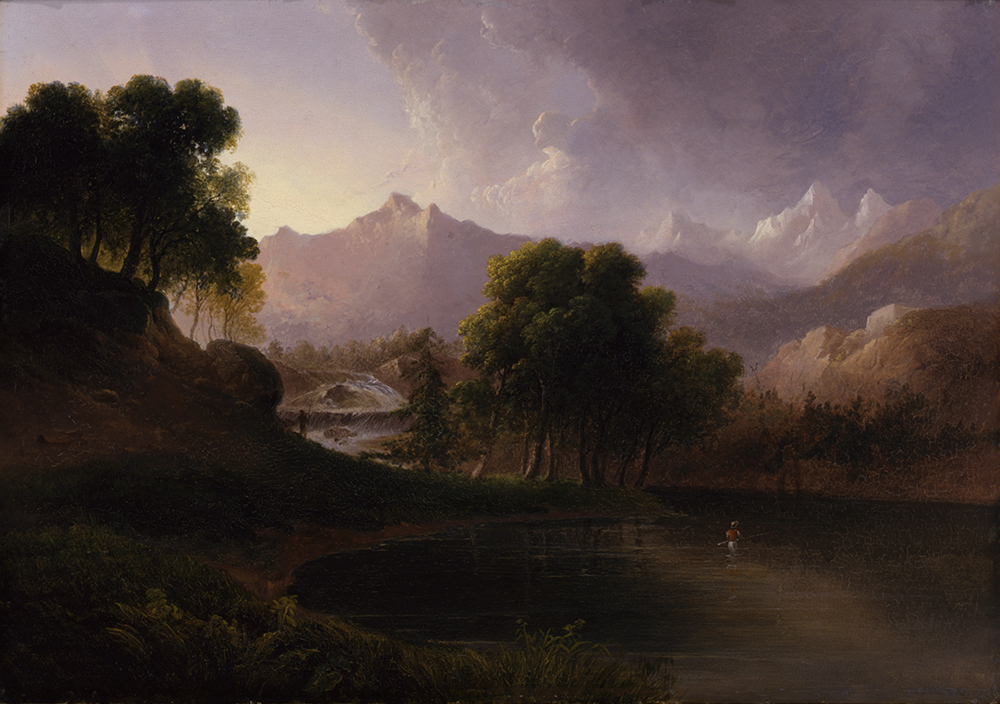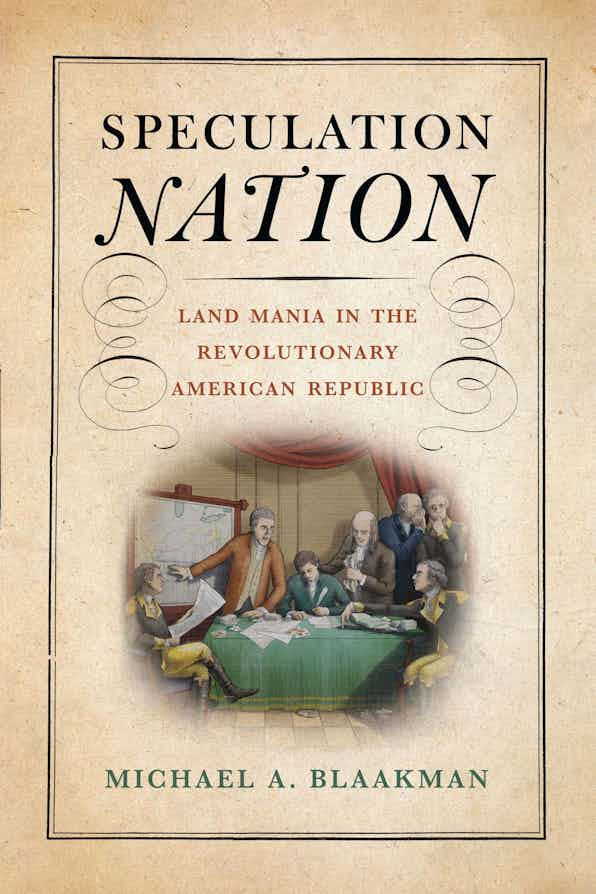
Swale Land, by Edward Mitchell Bannister, 1898. Smithsonian American Art Museum, gift of G. William Miller, 1983.
In the early summer of 1783, members of the Continental Congress straggled from Philadelphia into a sleepy town in central New Jersey. They had abandoned their seat at the Pennsylvania State House after nearly four hundred Pennsylvania soldiers marched on the building with fixed bayonets, demanding their promised back pay, while the state government sat idly by. Shaken and offended, the members of the impecunious Congress resolved to make Princeton their temporary home.
Several weeks prior, Congress had approved preliminary articles of peace with Great Britain. The provisional agreement set expansive bounds for the independent nation. Britain ceded its claim to all the territory between Quebec and Florida to the north and south, and the Atlantic and Mississippi to the east and west. As the members of Congress puttered around Princeton waiting to achieve a quorum, they read in the newspapers from New York and Philadelphia an address that George Washington had circulated to the states, announcing his intention to resign as commander in chief of the Continental Army. In it, he had dubbed American citizens “the sole Lords and Proprietors of a vast Tract of Continent.” The delegates might fairly have wondered what such dominion meant. In the months that followed, they debated how to put it into practice.
Congress that summer hardly seemed the representatives of a great territorial power. In exile, they shared beds in cramped rooms that the townspeople had offered up. They choked down “stinking fish & heavy half baked bread” and swilled “abominable wine” in “dirty tavern[s].” At the center of town, the College of New Jersey still showed scars from the battle that had culminated there six years prior, its buildings, library, and scientific equipment all damaged through months of plunder and combat. Visitors complained that the dilapidated campus was “covered with dung” from the farm animals that wandered into the college yard to graze. Convening to pass “riddles and sometimes resolutions” in the college’s main building, Nassau Hall, the new nation’s leading statesmen rubbed elbows with teenage scholars spouting the verse of Alexander Pope and dodged “warm steams” issuing from the students’ “beds, foul linen, & dirty lodgings” in the “sultry heat of the day.” When Washington took an audience with Congress, lacking a chair high enough to appropriately reflect his status, they directed him to sit atop a thick book. And throughout the summer, they fretted that the demise of their fragile union was imminent.
Nevertheless, during its time in Princeton, Congress floated plans for far-flung regions and other peoples’ lands that were stunning in their audacity. Delegates agreed to send representatives to Native nations to inform them of their alleged defeat in the Revolutionary War and to impose a punitive peace. They haggled over the terms by which states would cede to the union Native lands they claimed but did not control. They pondered the creation of new western states. And on September 22, in one of their first official acts regarding the West after approving the preliminary treaty with Britain, they issued a proclamation of their own—one that promulgated a key tenet of the detested Royal Proclamation that King George III had adopted twenty years prior, forbidding the unauthorized private purchase of lands from “Indians, without the limits or jurisdiction of any particular State.”
The reason for this surprising retention of British policy has to do with grandiose ideas about what the West could fund. White Americans of the revolutionary era forged an explosive connection between expropriated land, public finance, and the fulfillment of a republican social vision. For the revolutionaries, land was their new nation’s most abundant and important resource—both the canvas upon which they projected their hopes and the rug under which they swept their fears. Although most of the territory the new nation claimed in fact belonged to Native Americans, the patriots nevertheless placed tremendous faith in that land’s ability to solve the problems that plagued their revolutionary republic.

The United States was born in debt and swaddled in fiat currency. Both in Congress and in the thirteen states, patriot officials funded their war for independence by printing endless reams of paper money, which quickly depreciated in value, and by borrowing vast sums from voluntary and involuntary creditors alike: domestic elites, foreign merchants, European powers, Americans whose property was seized for the use of the army, and soldiers whose promised pay was persistently delayed. The nation’s debts to Continental soldiers carried particular moral potency, but all its outstanding IOUs were linked to patriot dignity and national honor. To continue borrowing, moreover, interest needed to be paid reliably. The principal, most thought, eventually needed to be paid down. And the work of getting new governments up and running only required further expenditures. Since the fires of revolution had been sparked amid tax protests, it was unlikely that taxation could foot the whole bill.
But patriots believed there was plenty of available land, and during the Revolutionary War, growing numbers of them saw it as an obvious remedy for their fiscal woes. In fact, some discerned a connection between expropriated land and public finance even before independence was declared. In early 1776 Thomas Paine cast North America’s vast extent of “unoccupied” land as one of the colonies’ greatest advantages in their military contest with the mother country. Rather than “being lavished by the king on his worthless dependents,” Paine wrote, American lands could be “applied, not only to the discharge of the present debt, but to the constant support of government.” Lands that once would have been freely granted to political insiders could instead be sold for public ends. “No nation under heaven hath such an advantage as this,” Paine gushed. Ignoring as he did the powerful Native nations who owned and controlled the land he referenced, his point could make a decade’s worth of controversial taxes on imported British goods seem downright ridiculous. The source of an American revenue had been beneath parliamentary noses all along.
Revolutionary leaders first endorsed selling land for public revenue the following year. This initial suggestion, though, dealt not with Indian country but rather with loyalist land. By the summer of 1777, the nation’s fiscal crisis was daunting. Continental currency had depreciated to a third of its original value. Skyrocketing prices—and price-gouging merchants bent on ensuring their profits despite runaway inflation—threatened to make it impossible for Congress and the states to supply soldiers with adequate clothing, weapons, and food. In July, delegates from New York and New England convened at Springfield, Massachusetts, to discuss the deepening fiscal quagmire. Urging the states to regulate prices, redeem bills of credit, abstain from further emissions of paper money, and levy “large and frequent taxations,” they forwarded their suggestions to Congress in August. In November, Congress assented. Currency inflation, its members declared, had led to the “decay of public virtue, a precarious supply for the war, [and] debasement of the public faith.” Congress therefore called on Americans, “hitherto spared from taxes,” to pay for the war effort. It repeated the northerners’ suggestions and added one of its own: confiscating loyalist property.
Radical patriots in several states had been advocating loyalist confiscation for months, hoping to punish hardcore Tories, to broadly redistribute their property among supporters of the rebellion, and to push fence-sitters toward declaring allegiance to the revolutionary cause. Though many elite patriots initially bristled at such an affront to property rights (and to the loyalists many of them knew closely), Congress ultimately endorsed confiscation because it could be useful to the problem of wartime finance. It resolved that states should “confiscate and make sale of all the real and personal estate” of the disaffected, urging them “to invest the money arising from the sales in continental loan office certificates.” Massachusetts delegate Elbridge Gerry, who had written the congressional committee’s response to the Springfield Conference, explained the rationale. Taxation, he noted, could be an “effectual Remedy” for keeping inflation in check and for covering military expenditures. But it was impractical during wartime and had little support among the public. A more workable solution—one that took advantage of wartime exigencies rather than being obstructed by them—was to sell loyalist property and use the proceeds to fund the bills of exchange that would function as interest payments on loan-office certificates. “Confiscated Estates…will produce large Sums for this purpose,” Gerry hoped. By linking confiscation to the problem of wartime finance, Congress made it seem worthwhile and politically practicable. Several states responded to the congressional recommendations with a spate of confiscation acts in 1778 and early 1779.
The idea of selling expropriated land in the service of state finance proved equally persuasive when patriots turned their attention from loyalists to another group that they deemed enemies of the Revolution: Indigenous people. Leading patriots began to promote the fiscal potential of Native lands during the waning years of the war. In 1781, Philadelphia political economist Pelatiah Webster published “An Essay on the Extent and Value of our Western unlocated Lands, and the proper Method of disposing of them, so as to gain the greatest possible advantage from them.” “Great revenue may be obtained” from the “vacant unsettled lands,” he wrote, with “proper and timely wisdom and care.” Anticipating that the states would cede their western territorial claims to Congress, Webster estimated that the “public property of the States General” would number some 300 million acres. “Sell[ing] the lands at vendue to the highest bidder,” he suggested, would net a revenue of $200 million in specie. Properly invested, that fund could yield an annual interest of $10 million. Webster’s highfalutin proposals made only scant mention of the Indigenous people whose land he considered the nation’s “common stock.” Acknowledging Native power but ignoring Native sovereignty, he suggested that it would be “much cheaper to purchase their lands, than to dispossess them by force”—though he did not suggest that they should have any say in the matter. The revenue to be gained, Webster concluded, was “much more than sufficient to defray the whole public expenses of the thirteen states, in a time of peace, and of course a large surplus to be laid up for a time of war.” This would be “an income vast indeed, not drawn at all from the purses of the people.” What little need, then, for taxes! Land would become “a fund to discharge the debt contracted by the war,” Charles Thomson, the secretary of Congress, reported from Princeton to his wife, Hannah, in 1783. Describing emerging plans for the Native territories Congress claimed northwest of the Ohio River, he explained that “the army first” would “have the lands promised them,” and a large portion of the remainder was “to be sold or assigned to public creditors.” Harnessing this fiscal potential required Congress to sustain the British empire’s 1763 reforms prohibiting private “Indian deeds,” so that Native title could be appropriated as a public resource. “Let a continental land-office be open’d,” Rhode Island’s delegates to Congress echoed, predicting that “purchasers enough will appear.” Aspiring landowners would accumulate public securities to exchange for tracts, driving up their market prices. The “Public credit” would be “revived.” The plan was so alluringly simple that it almost required Native erasure. There would be, as the Rhode Islanders saw it, “no injustice done to any one.”
Native lands sat at the center not only of white Americans’ fiscal solutions but also of their vision for a republican society. Property ownership, they understood, allowed citizens to exercise the political autonomy that self-government required. And they considered a broad equality of wealth essential to the survival of a republic. For Connecticut grammarian Noah Webster, “an equality of property,” especially “lands in fee simple,” was “the very soul of a republic”—more important, even, than virtue. Because “property is the basis of power,” Webster theorized, wealth equality formed “the whole basis of national freedom.” Continued access to Native land would preserve this political economy for growing generations of settlers and grant untold numbers the patriarchal household mastery that came with propertied independence.
“In a new Country, possessing immense tracts of uncultivated lands,” argued South Carolina planter Charles Pinckney, “there will be few poor, and few dependent,” at least among the nation’s white men. What Pinckney wishfully dubbed the “vast extent of unpeopled territory” would, he believed, ensure “more equality of rank and fortune in America than in any other country under the sun.” Many connected the social significance of Native lands to their fiscal potential. For Jonathan Heart, a Connecticut surveyor and a captain in Congress’s postwar frontier garrison, the “extent of valuable Teritory” in the Ohio country was “scarcely conceivable.” Americans “generally considered” it important, he reported, “to obtain a peacible possession of this soil,” not just “for the purposes of sinking our National Debt” but also to open a republican “Field for European as well as American Emigrants.” Perhaps, as historian Gregory Evans Dowd has implied, Native Americans would have been no better off without the creation of the republic. But in the minds of American revolutionaries, there would be no republic without the conquest, sale, and settlement of Native lands.
Excerpted from Speculation Nation: Land Mania in the Revolutionary American Republic by Michael A. Blaakman. Copyright © 2023 University of Pennsylvania Press. Excerpted with permission of the University of Pennsylvania Press.
